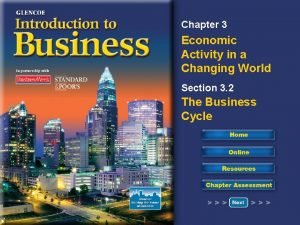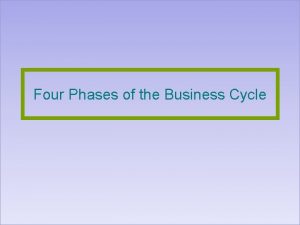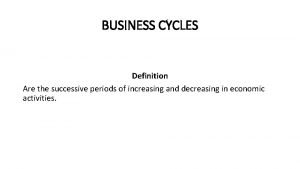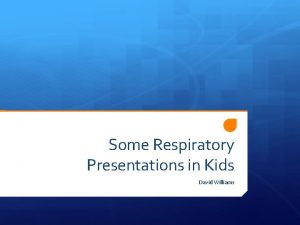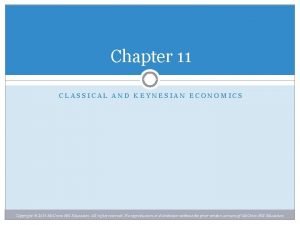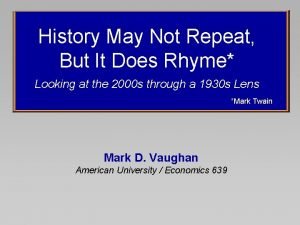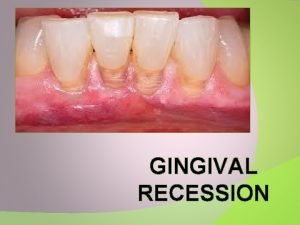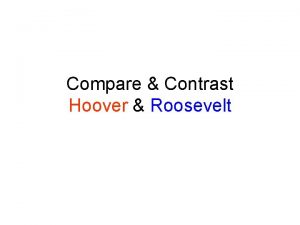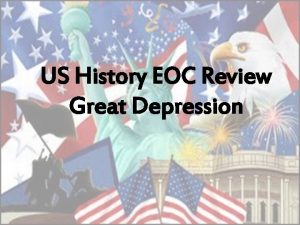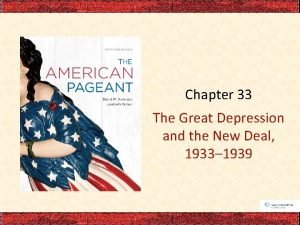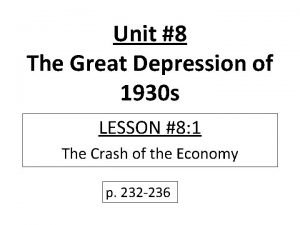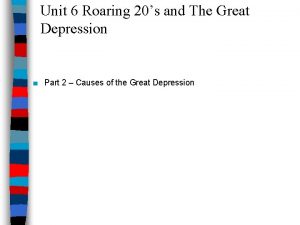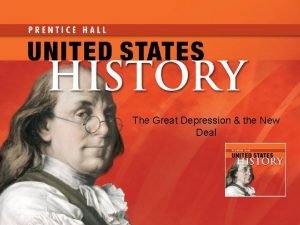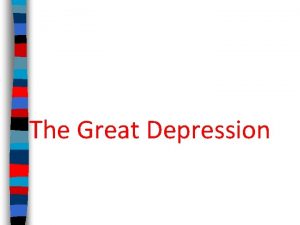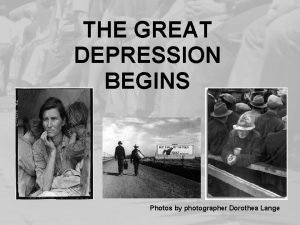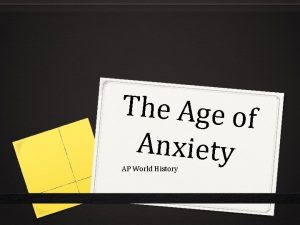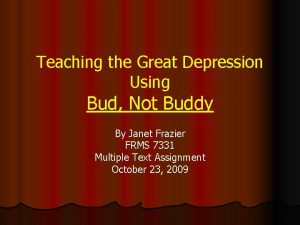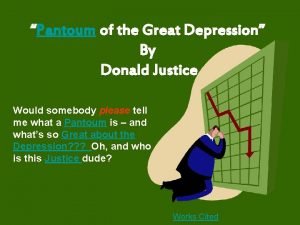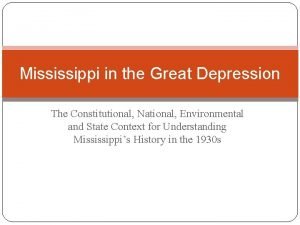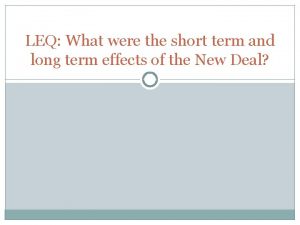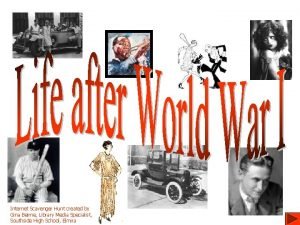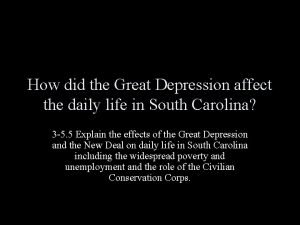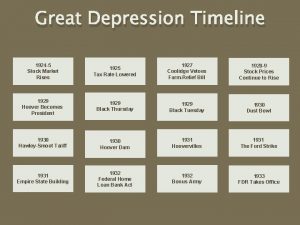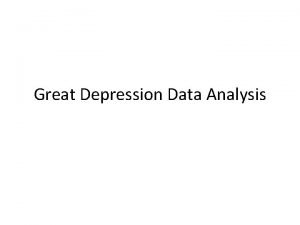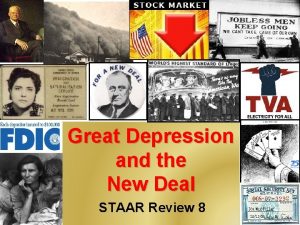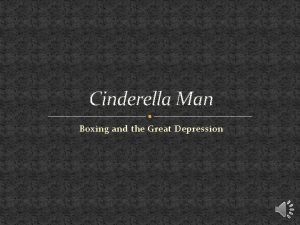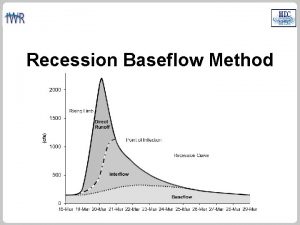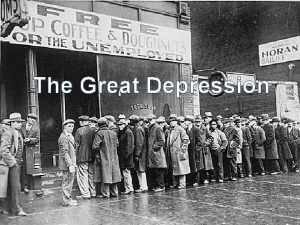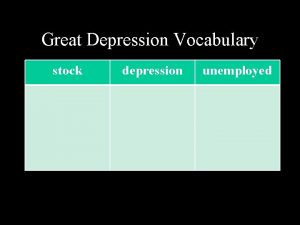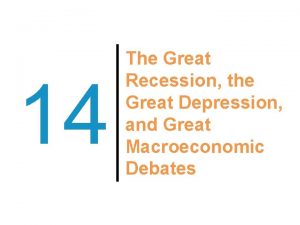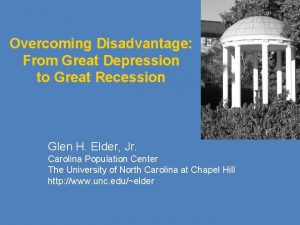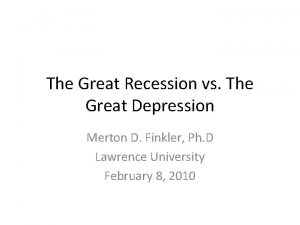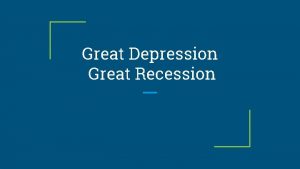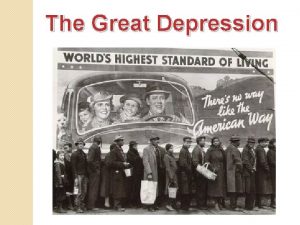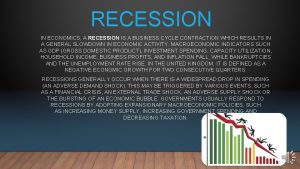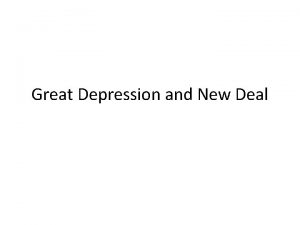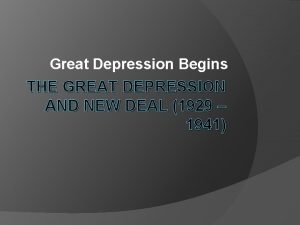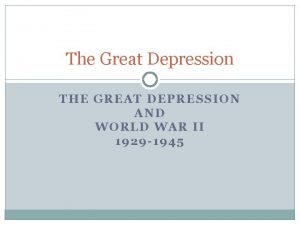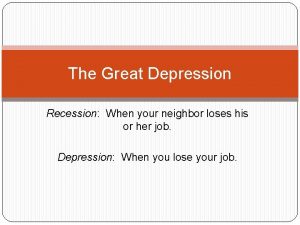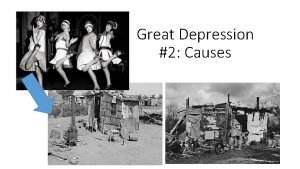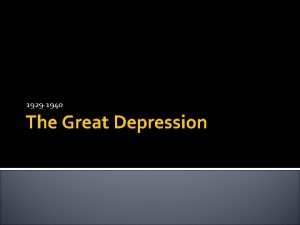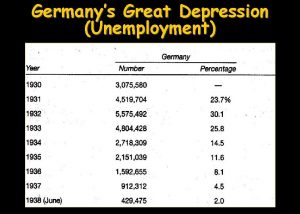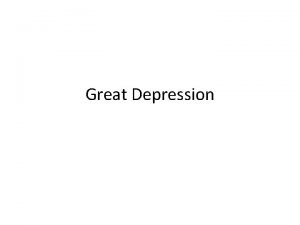27 The Great Recession the Great Depression and



































- Slides: 35

27 The Great Recession, the Great Depression, and Great Macroeconomic Debates

Previously • The AD-AS model is a simplified view of the economy that helps us evaluate short-term fluctuations in real GDP and unemployment • The AD-AS model helps us understand the macroeconomic impacts of real-world changes and gives us an important tool to use in government policy analysis

Big Questions 1. Exactly what happened during the Great Recession and the Great Depression? 2. What are the big disagreements in macroeconomics?

The Recession of 2008 • Officially from December 2007 to June 2009 – Longest recession since WWII • Named the Great Recession – Longer in length than other recessions – Deeper in effects than other recessions – Significant problems in the financial markets, similar to what happened during the Great Depression

Depth and Duration of the Great Recession— 1 • Figure 27. 1. a here

Depth and Duration of the Great Recession— 2

Analyzing the Great Recession with AD and AS— 1 • Trouble in the financial markets in 2007 – Real estate values fell in 2007. – As a result of securitization, falling real estate values led to a systematic problem in financial markets. – These markets exhibit international independence, and it became a worldwide problem. • Breakdown in the loanable funds market • Institutional breakdown shifts LRAS left

Analyzing the Great Recession with AD and AS— 2 • While institutional breakdowns affected AS, AD was also affected by: – Decrease in wealth • Real estate is often the single largest portion of wealth • Stocks lost one-third of their value in 2008 – Decrease in expected income • People realized the economy was faltering • Consumer spending decreases during times of uncertainty

Consumer Sentiment Index 2001– 2012

Great Recession, AS and AD Analysis

Great Recession Numbers • Second quarter of 2007 (prerecession): – Unemployment was below 5% – Real GDP was growing at 3. 6% • Fourth quarter of 2008 (during the recession) – Unemployment was 10% – Real GDP declined at an annual rate of 8. 9% • In 2012 (recession officially over) – Real GDP was growing at a rate of less than 2% – Unemployment remained at 8% – Government tried to return growth to normal

Practice What You Know— 1 • What was one of the main catalysts of the Great Recession, which began in December 2007? A. a large tax increase B. falling real estate prices C. bad monetary policy, which increased the money supply too much D. a lack of skilled labor

Great Depression • The Great Depression was much worse. • Great Depression statistics: – Economy contracted by 30% from 1929 to 1933 – It took 7 years for real GDP to return to its prerecession level. – Unemployment was 2. 2% in 1929 and 25% in 1933. – The unemployment rate was 15% for almost the entire decade of the 1930 s.

Real U. S. GDP 1870– 2015

Real GDP Comparison

Unemployment Comparison

Great Depression, AS and AD Analysis – 1 • The Great Depression was characterized by some unique conditions: – Effects were deep and long lasting. – It was actually two separate recessions (1929 to 1933 and 1937 to 1938). – Most remarkable: prices across the economy fell throughout the decade. • At the end of the 1930 s, the price level was still 20% lower than 1929. • Indicates that the primary cause of the Great Depression was a decrease in AD.

Great Depression, AS and AD Analysis— 2

Practice What You Know— 2 • What is true about the magnitude of the Great Depression? A. Output fell by 4% during the Depression. B. A large increase in the money supply almost caused hyperinflation. C. Prices rose higher than any time in the previous century. D. Unemployment reached a level of 25%.

Causes of the Depression— 1 • Macroeconomic policy – Government acts to influence the direction of the overall economy – Much of the Depression was caused by faulty macroeconomic policy. • Fiscal policy: – Use of government spending and taxes • Monetary policy: – Adjusting the money supply

Causes of the Depression— 2 • Stock market crash (Oct. 29, 1929—Black Thursday) → Lower expected future income → AD decreased → 1929– 1932: stock prices fell by almost 90% • Government policy response – Policymakers believed stock prices were too high → 1928 and 1929: government reduced the money supply → Lower money supply caused panic

Causes of the Depression— 3 • This policy error caused bank problems all over the country as financial panic spread. – – 1930– 1933: 9, 000 banks failed Government chose not to lend to these banks. Thus, the money supply decreased even further. 1929– 1933: money supply decreased by one-third • Most economists today think that – the money supply decline and – the resulting decrease in AD were the primary contributors to the beginning of the Great Depression

Great Depression: Other Factors • Taxes – Early 1930 s: Hoover and Roosevelt raised taxes in attempts to balance the budget → Further reduced AD • Smoot-Hawley Tariff Act – Imposed tariffs on thousands of imported goods – Initiated a trade war • Other countries taxed U. S. exports • Decreased global demand for U. S. products

Major Macroeconomic Debates — 1 • Classical economists: – Adjustment toward long-run equilibrium will happen naturally – Prices are flexible – Let the economy go and the market will correct itself • Keynesian economists: – Adjustment will be long and occur unpredictably with many delays – Prices are sticky – Call for government interventions in the market

Classical Economics • Economy is self-correcting. – Generally believe in the AD–AS framework shown – Economy comes back to full employment in the long run, no matter what curves shifted – Adjustments generally occur quickly • Policies – Pro-market, laissez-faire – No significant role for government intervention in macroeconomic policy – Focus on long-run growth (shifting LRAS) rather than AD shifts

The Strict Classical View

Practice What You Know— 3 • Classical economists will generally focus on policies that will A. B. C. D. cause short-run AD changes. emphasize increasing the LRAS. cause people to spend less money. prevent GDP from increasing too fast.

The Great Depression and Economic Theory • The conditions of the Great Depression were bad by almost any measure – Decade-long recession – From 1929 to 1933, real GDP fell 30% – 25% unemployment in 1933 – 15% unemployment over the 1930 s decade • and challenged the view of Classical economics.

Keynesian Economics— 1 • John Maynard Keynes, British economist – The General Theory of Employment, Interest, and Money (1936) – Theory of persistent cyclical unemployment – Wages adjust downward slowly due to contracts and salary expectations – High wages prevent labor markets reaching equilibrium and restoring full employment, creating a prolonged recession

Keynesian Economics— 2 • Focus on the demand side of the economy as the source of instability. • Government intervention is needed in prolonged recessions to boost demand restore the economy to long-run equilibrium. • Keynes: “In the long run, we are all dead. ”

Major Macroeconomic Debates — 2

Keynes vs. Hayek • Keynes vs. Hayek – Keynes: government intervention needed – Hayek: leave the market alone

Practice What You Know— 4 • The Great Depression led to the creation of what school of thought in economics? A. B. C. D. Classical Keynesian Ricardian Smithian

Practice What You Know— 5 • What is the main reason Keynes believed that the economy won’t return to equilibrium after a decrease in AD? A. the ineffectiveness of government intervention B. people wanted to remain in the depression because of lower prices C. sticky wages D. imperfect information

Conclusion • In the recent Great Recession, we experienced lower output and high unemployment • However, the Great Depression in the 1930 s was much worse and lasted much longer • Classical economists: – market is self-correcting – focus on long-run growth (expanding LRAS) • Keynesian economists: – market corrections can take a long time due to sticky wages – focus on policy aimed at AD
 Recession and depression
Recession and depression Boom recession depression recovery
Boom recession depression recovery Successive period
Successive period Agnosist
Agnosist Nbronchitis
Nbronchitis Monetarist vs keynesian vs classical
Monetarist vs keynesian vs classical Contractory monetary policy
Contractory monetary policy Words that rhyme with recession
Words that rhyme with recession Contour of gingiva in gingivitis
Contour of gingiva in gingivitis Definition of gingival recession
Definition of gingival recession Compare and contrast hoover and roosevelt great depression
Compare and contrast hoover and roosevelt great depression Tennessee valley authority new deal
Tennessee valley authority new deal Hardship and suffering during the depression
Hardship and suffering during the depression Pros and cons of the great depression
Pros and cons of the great depression Main idea
Main idea Chapter 33 the great depression and the new deal
Chapter 33 the great depression and the new deal Rarig great depression
Rarig great depression Great depression
Great depression Sec the great depression
Sec the great depression Foreclosure great depression
Foreclosure great depression Five effects of the great depression
Five effects of the great depression Five effects of the great depression
Five effects of the great depression How did the great depression impact the world
How did the great depression impact the world Great depression ap world history definition
Great depression ap world history definition Bud not buddy
Bud not buddy Pantoum of the great depression analysis
Pantoum of the great depression analysis Summary of great depression
Summary of great depression What is deflation
What is deflation Okies great depression
Okies great depression The great depression leq
The great depression leq Roaring twenties scavenger hunt answers
Roaring twenties scavenger hunt answers How did the great depression affect south carolina
How did the great depression affect south carolina What caused the dust bowl
What caused the dust bowl Great depression causes
Great depression causes Mexican repatriation apush
Mexican repatriation apush Hoovervilles
Hoovervilles
